A Long Time Ago... #7
Hello there.
Welcome to the seventh of these posts exploring art, fiction and history. Every other Sunday I share some insights into my two major passions - Star Wars and history, or specifically, ancient art.
Since the last one of these, I’ve gained a few new subscribers - thank you! And also since the last one, I properly announced my first article of the official Star Wars Insider magazine. If you haven’t already, you can read all about that here. Thank you everyone for the support! Onto the usual business…
Art as a means of representation, observation and meaning, has survived tens of thousands of years, expressed now in a mesmerising multitude of ways. I'm fascinated by its origins, and a particular subgenre of art known as the Star Wars franchise.
At the moment, I’m expressing and sharing this fascination by taking you through my timeline-ordered shelves of Star Wars books, as well as the ancient art sites that inspire(d) my writing.
In A Galaxy Far, Far Away…
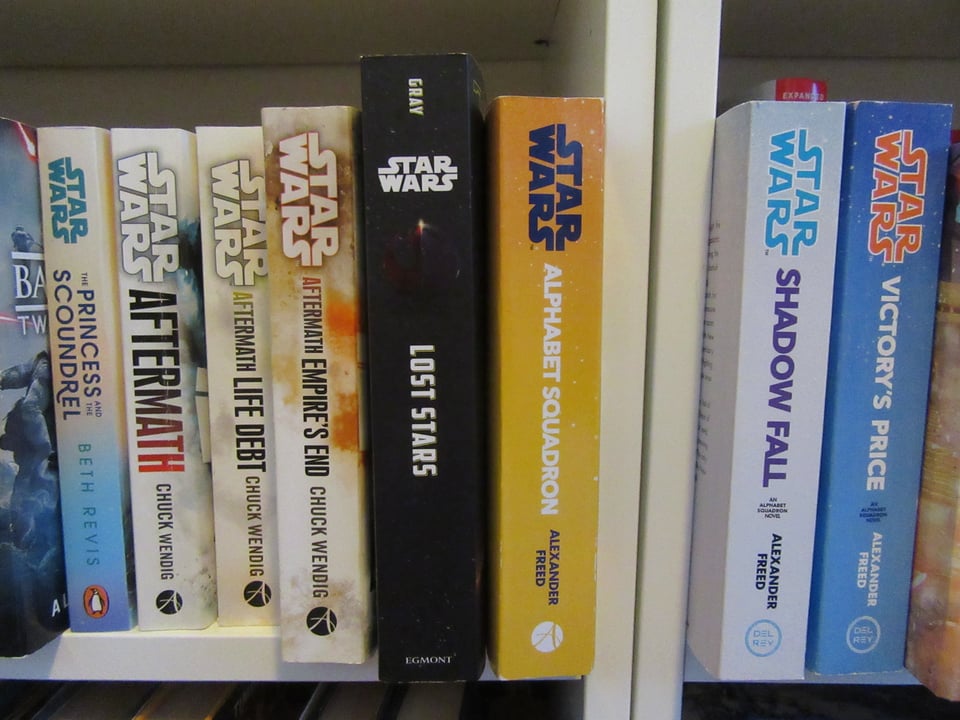
Now we’re firmly moving into ABY. For those who don’t know, the Star Wars timeline is measured by years before or after the Battle of Yavin, otherwise known as the destruction of the first Death Star in Episode IV: A New Hope. Episode V: The Empire Strikes Back is 3 ABY and Episode VI: Return of the Jedi, the last in the original trilogy, is 4 ABY.
As I mentioned in the last one of these, I’m missing two books, the end of the trilogy of 40 year (so 40 short stories) film celebrations, Return of the Jedi: From a Certain Point of View and the latest (junior) novelisation of the film, Beware the Power of the Dark Side! by Tom Angleberger.
So, today we’ll move straight onto the first batch of stories that fill in the long gap (30 years of in-universe New Republic rule, 32 in real life) between the oldest and latest trilogies.
The Princess and the Scoundrel by Beth Revis picks up right after the celebratory end of Episode VI, and explores Leia Organa and Han Solo’s wedding and honeymoon aboard the Halcyon Star Cruiser, which was the Star Wars-themed hotel at Disney World. I must admit I haven’t read this book yet (sorry Beth, if you’re reading this!) - I’ve been reading non-Star Wars stuff for a while, building up quite a list to read through when I launch back in. This is one of my most anticipated ones on that list though. I love Beth’s other Star Wars works and have been subscribed to her fantastic newsletter for a while now.
The Aftermath trilogy by Chuck Wendig is a masterpiece on par with any of the film trilogies, in my eyes. As the title suggests, this is the story of what happens after the Rebels’ victory at Endor, which is not the end of the war. The first novel contains some supporting characters from the Original Trilogy, but really fleshes out a fantastic misfit group of characters suddenly caught up in the midst of surviving Imperial leaders coming together, including Rae Sloane, first introduced in A New Dawn and serving as the main antagonist for the trilogy.
Aftermath was the first adult Star Wars novel I read, and boy did it suck me in to this incredible world. Not only did this feel cinematic, but it felt so Star Wars and expanded my knowledge and appreciation in so many ways. The whole trilogy is a fantastic link between film trilogies, chronicling monumental events but focussing on amazing small character moments. And it was just as monumental to my own writing. I can picture the room on holiday very clearly where I read this book - the first time I’d kept going back to a book throughout the day, and also the first novel I’d read in present tense, and with interlude segments set across the galaxy, relevant in their own ways to the grander storytelling. These interludes on different worlds made their way into my self-published series The Watchers - I wrote those sections in present tense that holiday and enjoyed that descriptive urgency so much I’ve written all three of my full-length novels in present tense since leaving school. Chuck Wendig’s Aftermath is the book that inspired the fourteen interlude short stories in my third WIP, based on all the sites around the world in the second halves of these posts. But back to the wars in the stars:
Aftermath: Life Debt does everything the first book does but more, I’d say, though this one brings well-known main characters back into the fold, really focussing on the Life Debt bond between Han Solo and Chewbacca, and how our ragtag group help liberate the Wookiee homeworld of Kashyyyk. As good second entries in trilogies do, this book also properly introduces the final confrontation set for the third book, introducing a much more ruthless Imperial and expanding the world and original characters even further.
Aftermath: Empire’s End finishes this trilogy that I should really call required reading to understand the history of the Star Wars galaxy between the Original Trilogy and Episodes VII, VIII and IX. I won’t spoil much about this third entry, only that it’s a masterpiece ending and so important to the Star Wars timeline. It balances all the characters we’ve grown to love, and even sees Han and Leia as new parents. All I will say is that the ending perfectly ties into other stories set at this time, whether books, comics, video games, explaining the ruins in the Jakku desert at the start of Episode VII: The Force Awakens, and even the name of the town where Rey sells her scavenged scrap. It made me feel like a truly knowledgeable fan for the first time, realising all these links.
Lost Stars by Claudia Gray is a triumph of a book, spanning the Star Wars timeline from the early days of the Empire until after its end in the final ages of the Aftermath trilogy. I placed it here as it would spoil where that trilogy’s heading, plus it’s a fantastic break between that and the next trilogy of novels. Anyway, this book is really about two characters, Thane Kyrell and Ciena Ree, star-crossed lovers. We see their journey from first being convinced to enlist to the Empire after seeing a speech from Tarkin, to ending up on opposite sides of the long civil war, tying these characters in to so much of the Original Trilogy. In the tapestry of stories, this is a long thread that touches many different scenes, giving you a bigger picture. In that way, and in others, it’s another Star Wars story everyone should read.
The Alphabet Squadron trilogy by Alexander Freed on the surface is similar to the Aftermath trilogy. Maybe it’s recency bias, but I’d say the ragtag group of pilots in these books have much more in depth character arcs, though. That is a main difference, that this trilogy focusses on an unusual pilot squadron, each flying a different ship (A-wing, B-Wing, D-wing, X-wing and Y-wing - seeing how they all come together is quite a tale!). It deals with the small scale ramifications of the end of the Empire, from both points of view, with the titular squadrons hunting down the old Imperial squadron of their leader, the dangerous Shadow Wing. It also brings back Star Wars Rebels character Hera Syndulla in her role as a general.
Shadow Fall and Victory’s Price, the second and third instalments in the trilogy, somewhat blend together in my mind, which is no fault of the authors but my own memory and the fact that I read them so quickly back to back once again on holiday. I know the former is the classic middle of the trilogy switch up, taking place primarily on a war-torn planet, and the latter rounds out the story in a very satisfying way for all the characters, paying off the intricacies of their stories.
They continue the central conflict between the two pilot squadrons, but what I really remember (without going into specifics) is the incredible inner and outer journeys the many POV characters go - allegiances, discoveries, relationships, juggled in a perfect Star Wars way with probably the best writing about space battles in the whole continuity. These stories also run concurrent to Aftermath and all the other stories at this time that explore Palpatine’s post-death plan, heading to Jakku for a third time. I love that we get that battle from at least five perspectives in canon.
This trilogy also has a five-issue prequel comic mini-series that focuses on the Empire’s TIE pilots. Speaking of tie, the books’ concepts and characters tie into the video game Squadrons. Freed also brings forward his Twilight Company characters for a sizeable section, and it was nice to see those familiar characters again. I really want to re-read both this trilogy and Aftermath, and Lost Stars, so I can fully catch every 5 ABY overlap rather than read them years apart. That’ll have to wait, though. I’ll have to make do with reading Amy Richau’s interview with Freed in the latest issue of Star Wars Insider (The one that I’m in!).
In Marseille, Bouches-du-Rhône Department, France…
While the reconstruction of Cosquer cave is in Marseille, the real cave’s entrance is underwater in the fairly nearby Calanque de Morgiou. (A calanque is defined as ‘a cove or inlet especially on the Mediterranean coast of France’.) I visited the reconstruction, with its faux submerging sequence and ride, cinema and museum, in May - I even got the T-shirt - and a postcard. I will be making a few additions to my story about the site, but today I’ll share this incredible cave’s story with you.

Humans occupied the cave from 33,000 to 19,000 years ago, a time when the Earth looked very different. In fact, I’m sure it looked very different between those two bookend dates too.
The first phase was by the Palaeolithic Gravettian culture, named after the site where their distinctive stone tools were first found. They’re behind the first negative handprints here, some of which you can see above. (I was sad you couldn’t use cameras inside the experience, but it’s understandable.) There’s different theories as to why some prints have missing fingers or sections of fingers - either they were cut off for some (ritual?) reason, or people held their hands at different angles to leave some sort of sign language message, like those still used by hunters.
To try and paint a picture, I can remember moving through a large domed chamber with stalactite chandeliers, drip dripping everywhere, and all along a wall’s soft surface was a collection of handprints, similar to some ancient graffiti in a church. Even in the recreation, there was something sacred about that spot.
The cave is thought to have been left for a while, until the next phase in the Epigravettian, when most of the animals were added, painted and etched. There’s so many other features too - an astounding amount of finger fluting, where ancient people traced their fingers through the soft wall or ceiling surface, leaving lines. It must’ve had some meaning, or they took some joy in it, because I didn’t realise the scale of that sort of marking at Cosquer. It was on the scale of a stipple ceiling pattern, but instead of old bedrooms it was the chambers of this special cave that had the organic swirls.
These were of course all done when the coastline was very different, the sea level was much lower. The cave sat as it was for ten thousand years, then became more and more inaccessible and now is partially submerged.
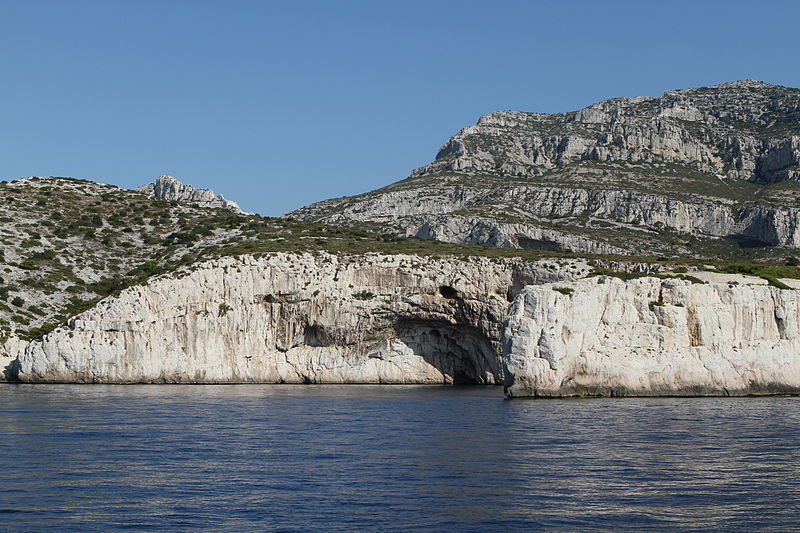
That’s the calanque as it is today, where Henri Cosquer did his famous dive and discovered the entrance in 1985. I think it took him a few years to navigate the 37 metre-long waterlogged tunnel before reaching ‘the beach’. He brought more and more friends, and it was only one expedition when he put his torch down at the right angle on a rock, that a negative handprint, one of 500 pieces of art in the cave, was revealed. I just love that story - and they had a replica torch in the reconstruction too!
But Cosquer Cave is sadly destined to disappear. Four fifths of the cave have already been lost to the water, and since the discovery of art in the open air section of the cave in 1991, the legs of a painted horse that predates farming by over ten thousand years have been washed away.
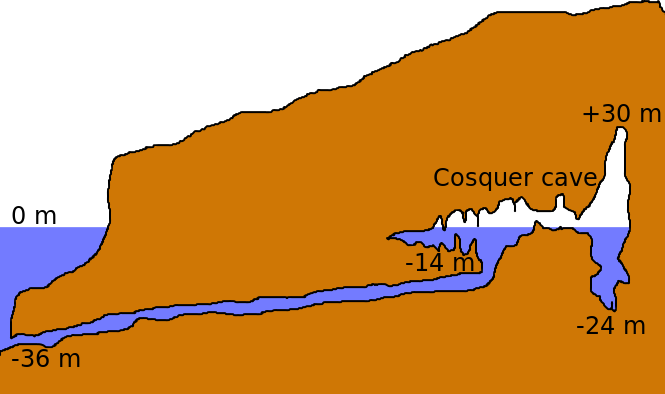
That’s why the reconstruction is so great - it’ll preserve a likeness of the cave at least how Cosquer found it, complete with a dead crab preserved in the flow of mineral, the shed shells of a pair of lobsters, the breathtaking fairy-crystal-grotto natural formations and the burn marks from ancient torches and fires. All the tangible artefacts give it a certain life beyond just the artwork.
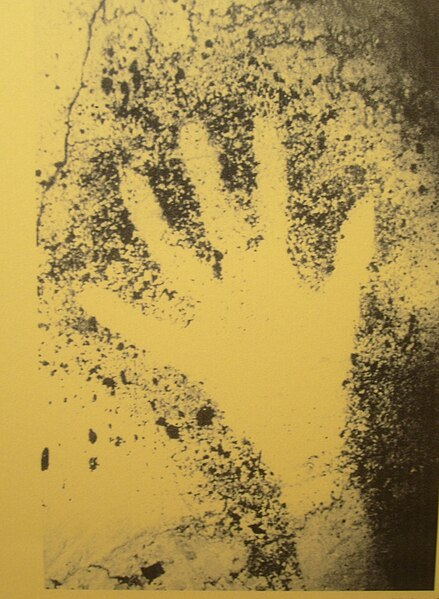
I think that photo is of a reproduction of a negative handprint in a different French museum. But let’s move onto the animals now, as Cosquer cave is a veritable bestiary!
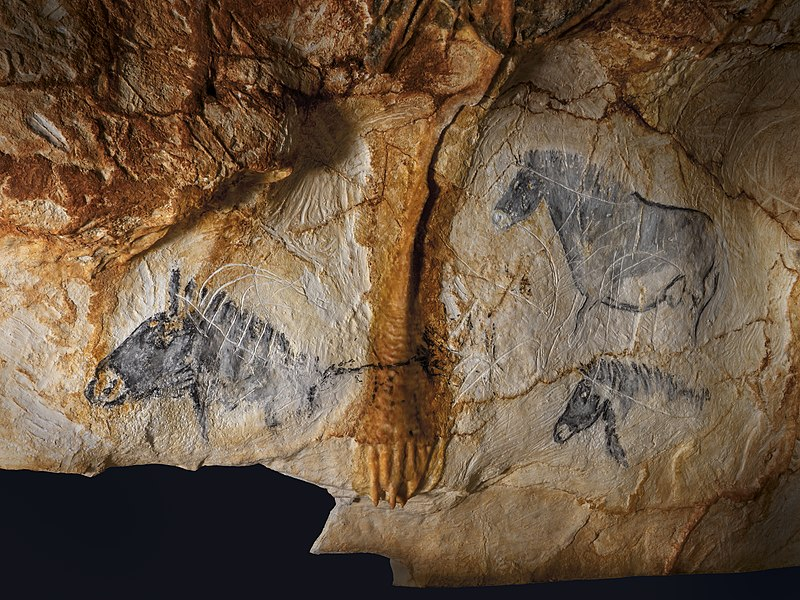
I think that’s a photo from the company who worked on the reconstruction. It not only showcases the lively shaded quality of this artwork, but a fraction of the many etchings, as well as some of the finger fluting I mentioned (north east of the horse on the left).
According to the signs at the site, there are eleven animal species represented. Over 45% are horses. Almost 25% are ibex. 14% are of the bovine variety, either the auroch ancestors of our cows or the extinct steppe bison. Deer make up 9%, the fourteen monk seal depictions are 6%, then we get into <5% territory with chamois, great auks, megaloceros, saiga (of which there are two, recognisable by their large noses!) and a feline face that’s probably a cave lion.
I also remember reading about possible fish and jellyfish depictions online, but they weren’t brought to our attention with any glowing outline or spotlight on the tour. I do have an old comprehensive book about the cave sitting my shelf that I really need to get to, to match my mental image with all that information before I give the story another pass, specifically as it features a certain (hybrid?) animal.
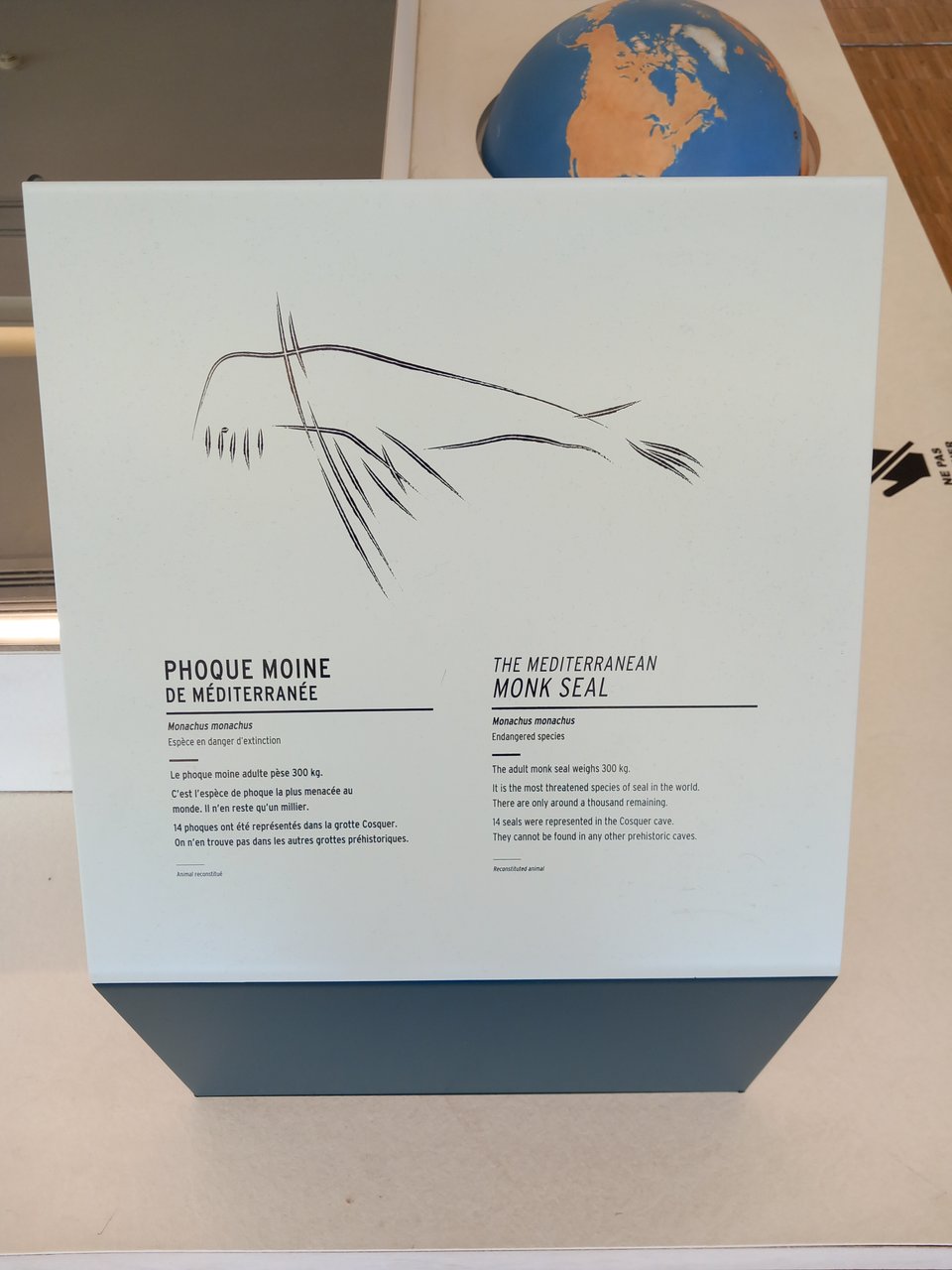
It’s the depictions of marine life that make Cosquer cave really special. I never realised how they were depicted with their whiskers, and the simple lines for their limbs. There’s also a supposed seal-headed man online, a ‘killed man’ in the book I own - nothing mentioned of him in the museum. Looking at the artwork in my book, it could just be another seal, but there is something different about this depiction. The head has no whiskers, though it is much more round than a human’s, like a smooth seal’s bulb shape. And the figure is posed as if someone falling, with limbs trailing over their main trunk. They’re also speared, much like the seal above.
Many seals and ibex were etched with lines through them, whether they’re spears or not. I remember one particular point in the cave where you’re looking straight up at almost a circular display like in some duomo dome. Maybe it was some special way to honour prey, or some later artist came along, didn’t think much of the composition and drew a line or two through each figure.
There is the other marine creature to talk about…
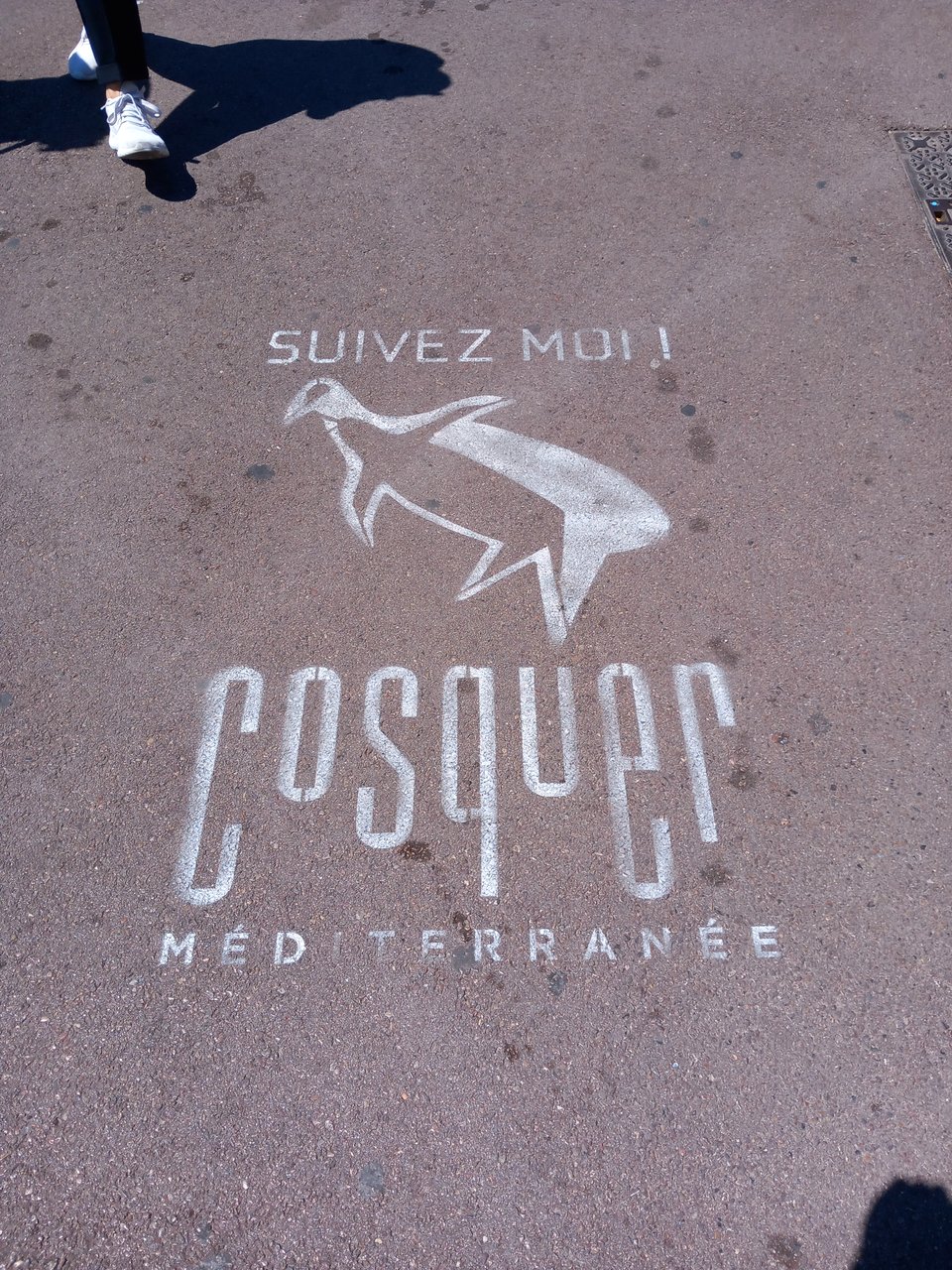
The handy pavement signage displays the museum’s logo - one of three great auk depictions. It comes from a scene on a vertical overhang I think - three auks (relatives of the little auk, puffins, guillemots etc.) in a sort of love triangle, two males in different stages of some mating parade to woo a female.
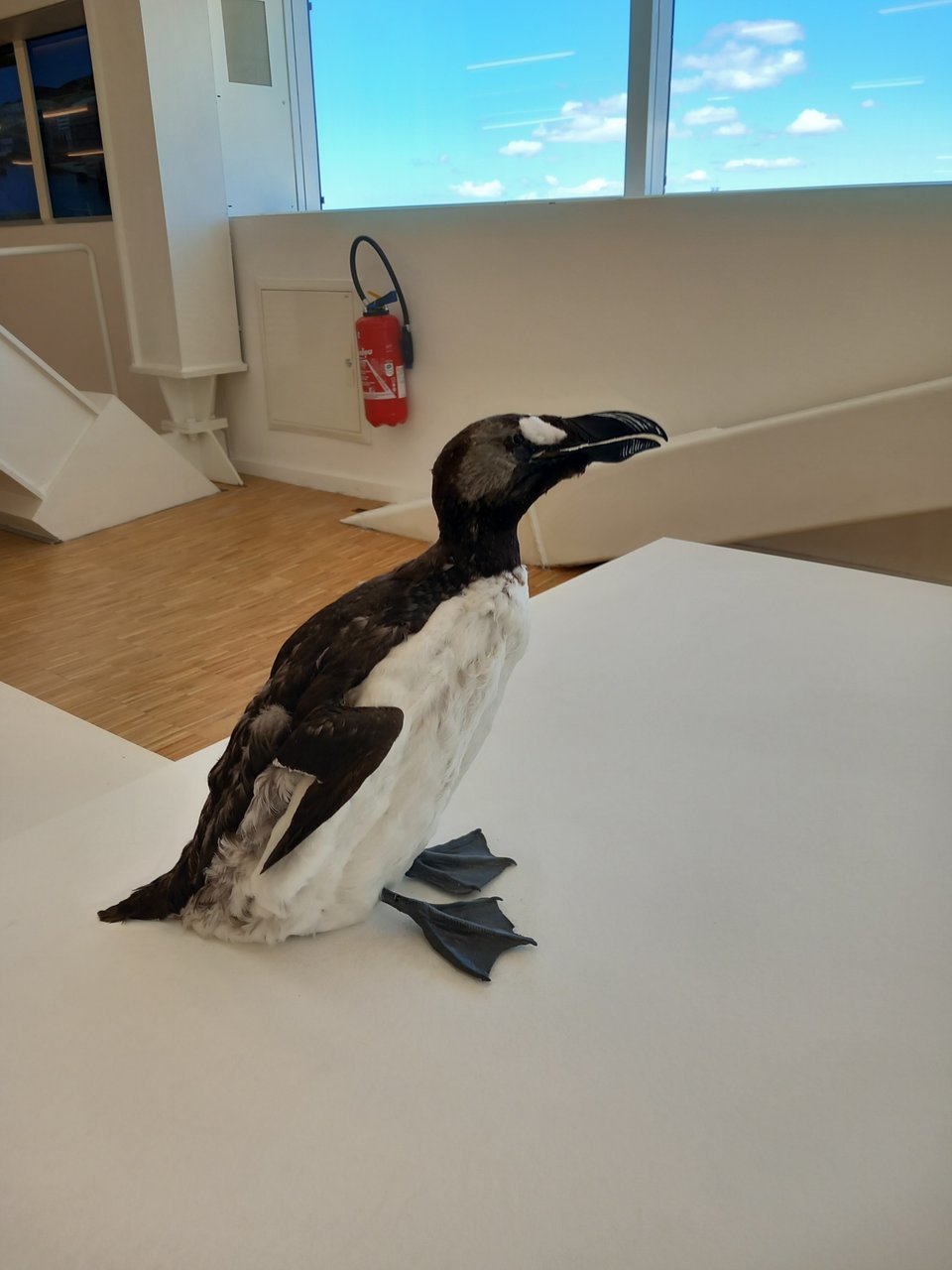
What the sadly-extinct bird would’ve looked like. It was a flightless bird, awkward on land but like a torpedo in the water. But this great avian, much like the better-known dodo and many lesser know species, went extinct due to us. It was easily hunted in the 18th and 19th centuries for its down and use as fishing bait. The last great auk was killed in Iceland in 1844. I doubt the Palaeolithic artist that recorded the natural phenomenon would think much of that. Sorry for that dour note to end on.
I don’t really have any quotes to share for this one either, as like I said in my May Roundup, the story itself takes place on a beach in the city, and sharing anything else would really spoil the story. I did give you lots of excerpts from last fortnight’s short story!
That brings us to an end of this exploration of a long time ago. I hope you enjoyed! I really appreciate the opportunity to sit down and write about these two facets of my reading/writing life, and know that people are reading. And now I can say that this is continuing the themes of my Insider article (just separately). Writing about rock art for that feature made me realise how much I enjoyed sharing what I’ve learnt, all these fascinating sites I’ve researched. And we all know I love Star Wars. So these posts are continuing that theme!
Thank you very much,
Harvey
P.S. Since today is both a Sunday and the last day of the month, my June roundup will be landing in your inbox three hours from this one.
